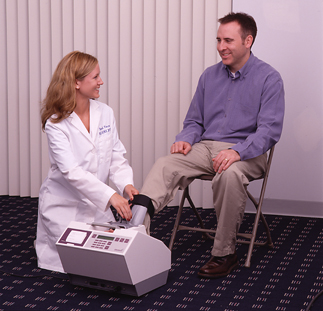 Bone Density Screening
Bone Density Screening
Bone Mineral Density (BMD) Screening – No Radiation can now be done in the doctor's office using the "SAHARA".
The
SAHARA uses fully dry ultrasound technology to estimate the density of
the calcaneus (heel bone), which is used to predict fracture risk of the
hip and spine. The SAHARA provides an easy-to-read printout of the
results and a T-score which compares the patient's bone to healthy adult
bone.
This exam requires patients to rest a foot comfortably in
the device for a painless, non-invasive, ultrasound measurement. The
entire procedure takes only a few minutes.
With your examination,
you will be given recommendations on how to healthfully maintain or
increase your bone density. If clinically indicated you will be referred
to your primary health care provider, with a copy of the test results.
Why screen for Bone Mineral Density?
The
ultimate purpose is to determine if a person's bone mineral density is
within an acceptable range as compared to a young adult (T-score). We
also evaluate bone density for a person of your age ( Z-score). The
SAHARA provides a low cost, radiation-free good first step in helping you identifying your bone mineral density level.
Who should be tested?
It
is important to assess your risk for bone density decrease through a
preventative health screening. Age recommendations for bone mineral
density screening varies. Ultimately it's up to you. Early screening
can make you aware that bone mineral density is less than optimal and
can alert you to a necessary change in lifestyle to help improve bone
density reserves when you are still young. Osteopenia is not a disease
like Osteoporosis but, Osteopenia is bone denisity that is less than the
age related normals. Diet can play an important role in building or
maintaining your bone density at any age.
Statistics say that
primary care doctors see 54 women over the age of 50 each week. On
average, 30% (or 16) of these 54 women have osteoporosis. Statistics
reveal that a significant number of women over the age of 50 begin to
have complications as a result of decreased bone density, especially
when other high risk factors are added.
If you have 1 or more of the following risk factors you may be a candidate for screening:
- All women over 65 regardless of risk factors
- Post-menopausal female
- Hysterectomy
- Caucasian of low body weight
- Family history of Osteoporosis
- Smoker
- Ever treated for low thyroid
- Ever had cortisone, or corticosteroid therapy (prednisone, steroids, etc)
- Individuals with primary hyperparathyroidism
- Have a low daily calcium intake
- Lack of weight-bearing exercise in daily routine
- Experienced height loss since 25 years old.
- Had a fracture after age 50
- Young women at a high risk, (bulimic, anorexic, or female athletes that stop menstruation for 3 months or more), as young as 21.
It is also important to consider getting a baseline examination for
comparison as you age. Your highest bone density will be achieved by the
age of 35. After this age the bone depleting processes begin to exceed
the bone building processes in the body, and the result will be some
bone loss over time. Men have higher bone density in general than women
and the result is a higher reserve as they age. There are exceptions,
though. You should do the best you can to support your bone density
through a healthy lifestyle all your life.
As you age, you may
confront complicating factors that effect bone density like some
medication, illnesses or accidents. You should desire to have enough
reserve bone density to avoid complications in the difficult times. The
best and most affordable options are those that involve lifestyle
choices you make today.
If I
have already had a DEXA scan and have been on medication, should I get
your screening to see if I have improved my bone density?
No. The SAHARA is not FDA approved to monitor your response to therapy. You should get another DEXA scan.
Is your osteoporosis equipment FDA approved?
The manufacture's pre-market application was approved by the FDA in March of 1998.
The Center for Devices and Radiological Health (CDRH) of the Food and Drug Administration (FDA) approved this devise to:
"perform
a quantitative ultrasound measurement of the calcaneus (heel bone), the
results of which can be used in conjunction with other clinical risk
factors as an aid to the doctor in the diagnosis of osteoporosis and
medical conditions leading to reduced bone density, and ultimately in
the determination of fracture risk"
Are there any clinical studies
that show that ultrasound bone densitometers that use the heel as the
measurement are accurate enough to benefit me?
A. Yes. The
National Osteoporosis Risk Assessment (NORA) Study, published December
12, 2001 in the Journal of the American Medical Association (JAMA) was
an assessment of osteoporosis in 200,000 postmenopausal women using
peripheral bone densitometers including the Sahara Bone Densitometer.
The conclusion for ultrasound testing was:
This study evaluates and confirms the validity of QUS (quantitative
ultrasound) as a useful modality in screening large populations for
osteoporotic risk.


